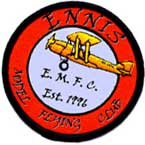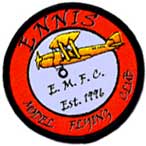 |
 |
|||||||||||
|
Some Rules... |
||||||||||||
|
|
Like any organisation, we have put in place some rules that aim to inform our members of what the agreed policys are in relation flying at our site. This in turn facilitates a consistent behavioural approach for all who operate at our club and therefore an efficient mechanism for ensuring that all activities are safe and enjoyable. Here are our Club Rules... • All members are charged with the responsibility of Safety Officer with regard to the implementation, by the members, of the following rules: • All Members must familiarize themselves with and implement the MACI Safe Codes of Practice as outlined at the end of this document. • At all times there must be due respect shown to the property owner and his property. • All models must display their EI registration number, as it is a required condition for MACI insurance. The letter height of the display must not be less than 15mm. • The purpose of the runway will be for taking off and landing only. All other persons are to remain behind the flight line, pilots and spectators alike. The pit area is only for working on aircraft. • Only the flying of fixed wing models is permissible. • Priority of use of the runway will be given to operators of models wishing to land and greater priority to a flying model with engine out. Models taking off have least priority. Operators will on all occasions signal their intentions by calling: “Landing” or “Landing… engine out” or “Taking off” as the case may be. • Your ability to fly safely is noted by your fellow members. Should you be making an approach to land in dangerous circumstances you must do the decent thing and ditch the model safely at a distance from the runway and other club members as outlined in the MACI Safe Codes of Practice. • You are reminded that high speed passes at low altitude in the vicinity of the runway and other such antics, which without doubt demonstrate your skill, also demonstrates your lack of respect towards other members. Although you may be a very good flier the integrity of your equipment can never be guaranteed. • The Gate must remain closed at all times. • Parking is to be confined to the same side of the road as the flying site. Vehicles must be parked tight to the ditch to allow free movement of other road users. If ground conditions permit then you may park inside the gate adjacent to the road frontage boundary. • You are not allowed to drive within the field beyond the inner road frontage boundary. • All grass clippings must be disposed of into the proper place. •Do not leave any form of litter on the field. This includes sweet wrappings, tissues, broken propellers or any item. •Members should familiarize themselves with the MACI Safe Codes of Practice as outlines below... The MACI Code of Safe Practice
The code applies to both Fixed wing and Helicopter types. Specific reference to helicopters are preceded by (H). Section 1: Before setting out for the field The following checks must be completed. 1. Is the propeller
the correct size for the model? Too small a prop can result in the
engine over revving, while too large a prop places excessive loads
on the engine. It should be free from nicks and other damage, and
properly balanced. Otherwise a prop may be shed when rotating at high
speed. An unbalanced prop can lead to excessive vibration in the airframe,
giving rise to many problems from radio failure to bits falling off
the airframe. When a spinner is fitted it should not exert pressure
on the blades on the propeller. It may be necessary to cut away the
spinner where it wraps around the blades to prevent contact. 2. Are the engine and silencer securely mounted? Even in the best constructed model there is some vibration present. The vibration has the effect of loosening the screws, allowing bits to fall off. Locking washers or locking compound should be used on all critical screws and nuts. 3. Are the receiver
and transmitter batteries fully charged? A discharged battery will
result in total loss of control, and loss of the model. Partially
discharged batteries may appear to function correctly while operating
the model on the ground, but when the model takes off and the distance
between transmitter and receiver increases loss of control may be
experienced due to range problems. Hence the importance of range checks.
The types of cell used in most r/c equipment (Ni-Cad) have discharge
characteristics where they operate normally when discharging and then
without warning go flat. A full 16 hour charge is needed before a
flying session. One must be particularly wary of old batteries, or
equipment laid up for a number of years. It is a false economy not
to replace all such batteries. The aerial also needs to be properly
installed, not looped around itself, and exiting the model to allow
the maximum length outside. It is recommended that it be tied to the
tail fin securely. Range checks should take place before flying any
new model, when any equipment is first used after an accident, or
when any equipment is changed in a model. The model should be range
checked on the ground with the engine running, the transmitter aerial
down, and signal checked from a distance. 4. Has the centre
of gravity been checked and adjusted where necessary? This balance
point of a model has a major effect on the stability of a model. If
it is too far back the model may be so unstable as to be uncontrollable.
A forward CG will normally result in a more stable model. The desired
balance point should be indicated on the plan or instructions, which
came with the model. If it is not as indicated it must be adjusted,
preferably by moving existing equipment, for instance the receiver
battery pack forward or aft, or, if this is not possible, by adding
weight to the nose or tail. 5. Are all the control surfaces and hinges secure? Do they move in the orrect directions? Looking at a model on the ground it is difficult to imagine the stresses and forces on the airframe and surfaces in flight. Try putting your hand out the window of a car travelling at sixty miles per hour, and feel the force of air striking your hand to appreciate the effect on a model. For this reason it is imperative that all control surfaces are well secured. Hinges should be well glued and pinned where necessary. 6. Are the control
movements correct? Elevator controls pitch, aileron controls roll,
and rudder controls yaw on an aeroplane. It is vital to check that
all the surfaces move in the correct direction and that the mount
by which the surface moves is appropriate for the particular surface
and model. An experienced modeller should always check this aspect
of the model set-up. 7. Does the engine
stop when the stick and trim are fully back? Apart from the fact that
it is normally necessary to be able to stop the engine for landing,
it can also be useful at other times. For instance during a test flight
if the model is virtually uncontrollable, stopping the engine can
slow things down enough to make flying manageable, and allow the model
to be landed “dead stick”.8.
Are all the linkages secure? Plastic clevises split easily, and detach
from the control horn or servo arm. The clevises should be screwed
on to the threaded end sufficiently far to ensure adequate grip. When
cables are used the outer casing must be securely supported at both
ends. 9. The following
mechanical checks should be made; loose or missing nuts or bolts,
fuel tank and piping secure. Section 2: On arrival at the field. 1. Check flight line /pits/parking arrangements and park your vehicle accordingly. The flight line must not over fly the pits or the parking area. The pits area must be chosen taking into account the direction of the wind. 2. Are the weather conditions suitable for the model, and for the experience level of the pilot? Wind condition and visibility must be taken into account.3. Do not switch on the transmitter. Twenty six channels are available, (numbered 60-85) but only one model at a time may use any given channel. Switching on a second transmitter on the same channel will result in interference to the first model, with potentially disastrous consequences. Check which control system is in operation (usually called a pegboard) and comply with these rules at all times. 4. As an added precaution call out your channel number aloud a few seconds before switching on to alert other pilots to a possible clash. 5. Ensure that
the wings are properly secured to the fuselage. If bands are used
ensure that they are of sufficient quality and quantity. A inimum
of six is recommended. 1. Have someone trustworthy to hold the model securely. 2. Ensure that
all leads, tools, clothes etc. are well clear of the prop. 3. Ensure that nobody is standing in line with the prop disc. Any bystanders should stand behind the model to avoid danger. 4. If flick starting
the engine, use finger protection. 5. When the engine
has started perform all adjustments from behind the model. 6. Ensure that
the model is restrained at all time when the engine is unning. Hold
the nose of the model up to ensure that the engine will not lean out
and stop. 7. Models should be started, and adjustments made only in the pits area. Section 4: Flying the model 1. The model must not be flown over cars, people, property, or any other area, which would constitute a hazard in the event of loss of control, or an engine cut. 2. “Dead stick” must be called out in the event of an engine failure to alert other fliers to give priority and to keep the runway clear. 3. “Landing”
must be called clearly to alert others in the area. 4. All take offs
and landings must take place into wind. 5. Pilots should
stand together when flying, with their backs to the pits area. 6. Last thing before takeoff, check all controls for correct movement and direction.
|
|||||||||||